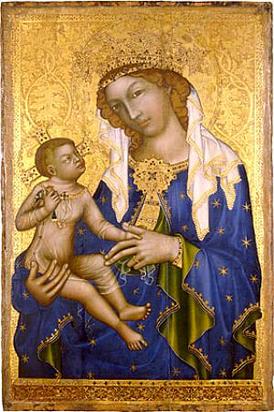 Mary, the Mother of God, introduced herself as "I am the Blessed Virgin of the Poor" to an 11 year old girl in 1933. I am not all that familiar with this devotion to Our Lady of Banneux, but it is very appealing to me because of the gentleness of the vision and connection with the poor and the sick.
Mary, the Mother of God, introduced herself as "I am the Blessed Virgin of the Poor" to an 11 year old girl in 1933. I am not all that familiar with this devotion to Our Lady of Banneux, but it is very appealing to me because of the gentleness of the vision and connection with the poor and the sick.Blessed Virgin Mary: January 2010 Archives
 Mary, the Mother of God, introduced herself as "I am the Blessed Virgin of the Poor" to an 11 year old girl in 1933. I am not all that familiar with this devotion to Our Lady of Banneux, but it is very appealing to me because of the gentleness of the vision and connection with the poor and the sick.
Mary, the Mother of God, introduced herself as "I am the Blessed Virgin of the Poor" to an 11 year old girl in 1933. I am not all that familiar with this devotion to Our Lady of Banneux, but it is very appealing to me because of the gentleness of the vision and connection with the poor and the sick.
God our Father, may we always profit by the prayers of the Virgin Mother Mary, for You bring us life and salvation through Jesus Christ her Son who lives and regins with You and the Holy Spirit, one God, for ever and ever.
from Catechism of the Catholic:
Called in the Gospels "the Mother of Jesus," Mary is acclaimed by Elizabeth, at the prompting of the Spirit and even before the birth of her son, as "the mother of my Lord." In fact, the One whom she conceived as man by the Holy Spirit, who truly became her Son according to the flesh, was none other than the Father's eternal Son, the second person of the Holy Trinity. Hence the Church confesses that Mary is truly "Mother of God." (495).
from the Directory on Popular and the Liturgy: The Solemnity of the Holy Mother of God:
On New Year's Day, the octave day of Christmas, the Church celebrates the Solemnity of the Holy Mother of God. The divine and virginal motherhood of the Blessed Virgin Mary is a singular salvific event: for Our Lady it was the foretaste and cause of her extraordinary glory; for us it is a source of grace and salvation because "through her we have received the Author of life."
The solemnity of the 1 January, an eminently Marian feast, presents an excellent opportunity for liturgical piety to encounter popular piety: the first celebrates this event in a manner proper to it; the second, when duly catechised, lends joy and happiness to the various expressions of praise offered to Our Lady on the birth of her divine Son, to deepen our understanding of many prayers, beginning with that which says: "Holy Mary, Mother of God, pray for us, sinners".
In the West, 1 January is an inaugural day marking the beginning of the civil year. The faithful are also involved in the celebrations for the beginning of the new year and exchange "new year" greetings. However, they should try to lend a Christian understanding to this custom making of these greetings an expression of popular piety. The faithful, naturally, realize that the "new year" is placed under the patronage of the Lord, and in exchanging new year greetings they implicitly and explicitly place the New Year under the Lord's dominion, since to him belongs all time (cf. Ap 1, 8; 22,13)
A connection between this consciousness and the popular custom of singing the Veni Creator Spiritus can easily be made so that on 1 January the faithful can pray that the Spirit may direct their thoughts and actions, and those of the community during the course of the year.+New year greetings also include an expression of hope for a peaceful New Year. This has profound biblical, Christological and incarnational origins. The "quality of peace" has always been invoked throughout history by all men, and especially during violent and destructive times of war.
The Holy See shares the profound aspirations of
man for peace. Since 1967, 1 January has been designated "world day for
peace". Popular piety has not been oblivious to this initiative of the
Holy See. In the light of the new born Prince of Peace, it reserves this day
for intense prayer for peace, education towards peace and those value
inextricably linked with it, such as liberty, fraternal solidarity, the dignity
of the human person, respect for nature, the right to work, the sacredness of
human life, and the denunciation of injustices which trouble the conscience of
man and threaten peace. (115-117)

